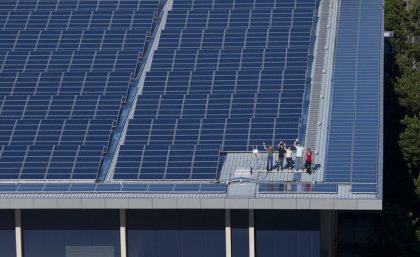
By John Quiggin, The University of Queensland
The question of whether the future will be powered by coal and oil or by renewable energy is crucially important, both to the medium-term future of the Australian economy and to the long-term future of the planet. For either to succeed, there is a storage problem to overcome.
A future based on “clean coal” can only be achieved through the large-scale implementation of carbon capture and storage (CCS). That is, the carbon dioxide generated by fossil fuels must be captured at the point of combustion and then stored indefinitely in underground repositories, or perhaps in biomass such as trees.
On the other hand, the main renewable energy sources – wind and solar panels – face a different storage problem. Wind is intermittent and solar power is generated only during the day, as well as being affected by cloud cover. So a system dominated by renewables must either use variable pricing to manage demand, or include some form of energy storage.
Presented this way, the problem seems symmetrical. In reality, however, the problem of energy storage has many possible solutions, whereas that of CCS has only a handful, none of which look likely to work. To see why this is so, let’s first consider the broader phenomenon of renewable energy.
Cost-competitive renewables
Over the past decade, the cost of renewable electricity generation, most notably solar, has plummeted. It has now reached the point where, in many locations, it is cost-competitive with new coal-fired power, even in the absence of targets, subsidies or high carbon prices.
At the same time, we have seen significant advances in electric and hybrid vehicles, although market shares remain small. The result is that it is now possible to contemplate an all-renewable energy system, encompassing both electricity generation and electric vehicles, developing over the next few decades.
It is no coincidence that these developments have occurred at precisely the time when concerns about climate change have become pressing. The need to stop burning carbon-based fuels has created both market and non-market incentives to find solutions to the problem. Where carbon prices exist or are seen as likely to exist in the future, they create a demand for any carbon-free technology that will deliver energy in a useful form (electricity or vehicle power).
Bright researchers, motivated both by the importance of the problem and the availability of research funds, have focused their attention on renewable energy and away from other topics that have declined in relative importance (the advice to Dustin Hoffman in The Graduate that “plastics” were the one-word key to a prosperous future comes to mind).
Emissions trading schemes and renewable energy mandates have encouraged firms to invest in the research and development work needed to turn theoretical advances into marketable products. Feed-in tariffs and other incentives have encouraged electricity generators and households alike to adopt these products. In turn, this has created a virtuous circle where growing demand drives cost reductions (because of the economy of scale), which then drives demand still further.
The result is that solar panels are now being installed globally at a rate of a gigawatt every week, almost as much the total amount installed during the 20th century.
There is nothing mysterious about the fact that research into carbon-free energy has been successful. The nature of the problem ensures that the range of potential solutions is vast. Anything that can turn a turbine can generate electricity. That includes physical forces like wind, waves and tides; fuels that can boil water to make steam; and heat differences like those that drive geothermal energy. The energy in sunlight can also be turned into electricity, either by concentrating its heat or through the photovoltaic effect in solar panels.
When the push for renewable energy began in earnest at the beginning of this century, there was no way to know if any particular one of these technologies would be cost-effective or applicable on a large scale. Each represented a bet, at fairly long odds, that the limitations that had previously prevented large-scale deployment of these technologies could be overcome.
But betting on a lot of horses, even if all of them are outsiders, gives a good chance of backing at least one winner. And so it has proved. While geothermal and concentrated solar energy have made only modest progress, and wave and tidal energy hardly any, bets on wind power and solar photovoltaics have proved successful.
Storage solutions
The problem of energy storage can be thought of in the same way. Any reversible process involving energy constitutes a potential storage technology. Going one way, the process uses energy derived from an electricity source that is in excess supply, such as solar panels at noon, or wind turbines turning late at night during low demand. Going the other way, the stored energy is turned back into electricity. Some energy is lost along the way, and other costs must be met, but if the difference in demand is great enough, there is still a net benefit.
The general nature of the storage problem means that the range of possible solutions is vast. The reversible process might involve chemical energy (as in batteries), heat energy (as in off-peak hot water), kinetic energy (as in flywheels) or potential energy (as in pumped hydro). This means that solutions could be found to a wide range of energy storage problems, depending on whether the crucial requirement is cost, speed, or energy density.
Power stations might prioritise cost-effectiveness, for example, or speed and flexibility. Car batteries, meanwhile, need dense energy storage. It will take some time to adapt existing solutions to new requirements, or to develop wholly new solutions. But this process is already under way, and substantial progress is being made.
The carbon horse is a long shot
The contrast with carbon capture and storage is striking. A CCS technology involves three stages, each with a limited range of technological options. First, the carbon dioxide from fossil fuels must be captured before it escapes into the atmosphere. Even the best available technologies involve the loss of up to 30% of the energy generated through combustion.
Second, the captured carbon dioxide must be transported to a storage site. This could be avoided by building the power station close to a suitable site, but that would probably add costs in terms of fuel transport and long-distance power transmission.
The final and most difficult step is the storage itself. The current best approach involves pumping the carbon dioxide into an underground repository, which must be stable enough to prevent leakage over an indefinite period. This approach has proved too expensive except, ironically, in places where the pressurized gas is used to help recover yet more crude oil from depleted wells.
To sum up, if investing in energy storage is like backing every horse on a race, investing in CCS is like a parlay bet), which pays off only if we can pick the winners of several races in succession.
When you think about it like that, it’s not surprising that the smart money is on storing energy, not carbon.
This article was originally published on The Conversation. Read the original article.
![]() The views expressed in this article are not necessarily those of The University of Queensland.
The views expressed in this article are not necessarily those of The University of Queensland.
.jpg)







